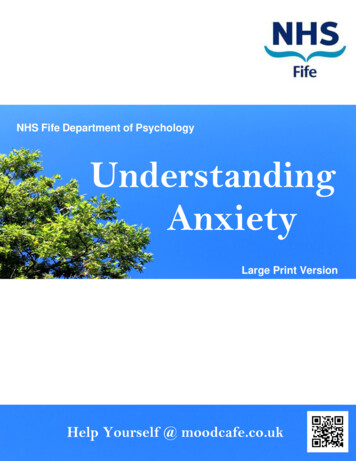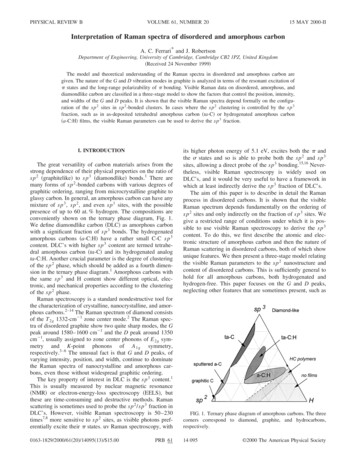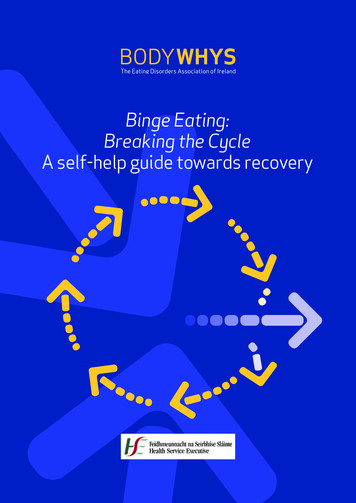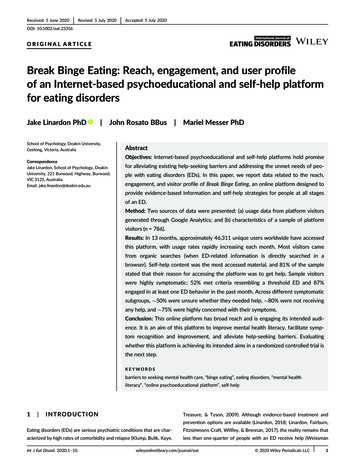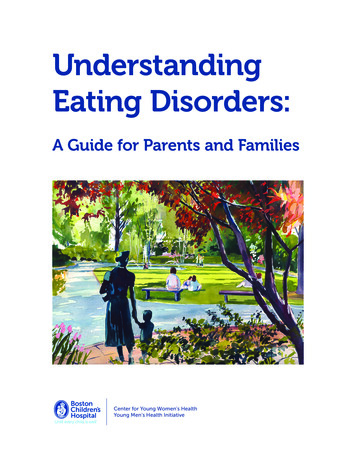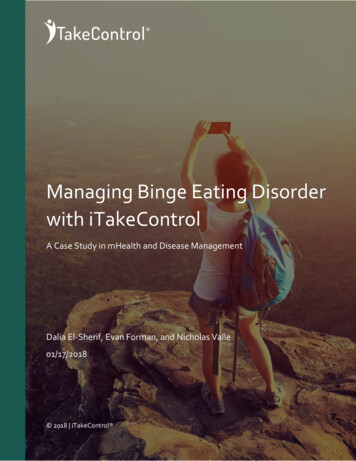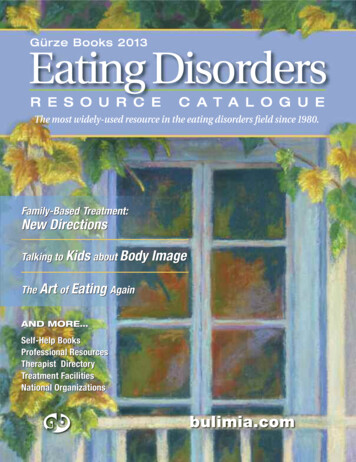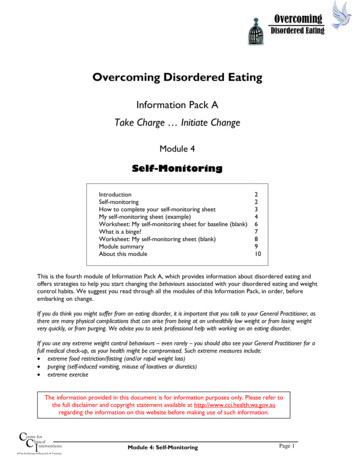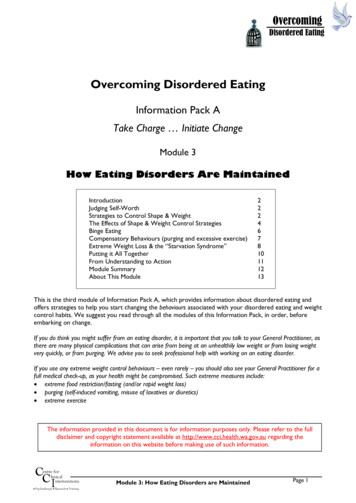
Transcription
OvercomingDisordered EatingOvercoming Disordered EatingInformation Pack ATake Charge Initiate ChangeModule 3How Eating Disorders Are MaintainedIntroductionJudging Self-WorthStrategies to Control Shape & WeightThe Effects of Shape & Weight Control StrategiesBinge EatingCompensatory Behaviours (purging and excessive exercise)Extreme Weight Loss & the “Starvation Syndrome”Putting it All TogetherFrom Understanding to ActionModule SummaryAbout This Module222467810111213This is the third module of Information Pack A, which provides information about disordered eating andoffers strategies to help you start changing the behaviours associated with your disordered eating and weightcontrol habits. We suggest you read through all the modules of this Information Pack, in order, beforeembarking on change.If you do think you might suffer from an eating disorder, it is important that you talk to your General Practitioner, asthere are many physical complications that can arise from being at an unhealthily low weight or from losing weightvery quickly, or from purging. We advise you to seek professional help with working on an eating disorder.If you use any extreme weight control behaviours – even rarely – you should also see your General Practitioner for afull medical check-up, as your health might be compromised. Such extreme measures include: extreme food restriction/fasting (and/or rapid weight loss) purging (self-induced vomiting, misuse of laxatives or diuretics) extreme exerciseThe information provided in this document is for information purposes only. Please refer to the fulldisclaimer and copyright statement available at http://www.cci.health.wa.gov.au regarding theinformation on this website before making use of such information.forCentrelinicalC Interventions Psychotherapy Research TrainingModule 3: How Eating Disorders are MaintainedPage 1
OvercomingDisordered EatingIntroductionIn Module 1 we talked about what eating disorders are and the negative impact they can have on a person’slife. In this module, we will explore the various things that keep eating disorders going. We call these‘maintaining mechanisms.’ As we go along, we will map out these maintaining mechanisms in the form of adiagram, which we call a ‘model.’ This model will help you understand your disordered eating and whatkeeps it going. We will show you how eating disorders form a vicious cycle and in later modules we willshow you how this cycle can be broken.Judging Self-WorthYou might have heard and seen words like “self-esteem”, “self-image,” “self-perception,” and “selfconcept.” All these terms refer to the way we view and think about ourselves. As human beings, we havethe ability to not only be aware of ourselves but also to place a value or a measure of worth on ourselvesor on aspects of ourselves. In general, people measure their worth and happiness based on a variety ofthings, such as their relationships, intelligence, achievements at school or work, hobbies, leisure activities,and other abilities. People with eating disorders tend to judge themselves and their worth largely, or evensolely, in terms of their eating habits, shape and weight, and their ability to control these.This system of self-evaluation may have developed through particular life experiences, and/or the influenceof family, friends, and the media. In many Westernised societies and cultures there is a strong pressure tobe thin. Not only is thinness considered to be important, but it is equated with being attractive, desirable,successful and in control – in short, being of worth. This idea is taken to extremes by people with eatingdisorders. They put enormous effort into controlling their eating in order to control their weight andshape. This is an issue that is central to what keeps eating disorders going.Take a few moments to jot down how you see yourself. How much are your judgementsof yourself and your worth based on your physical appearance, such as your shape orweight? Do you tend to judge yourself on your ability (or inability) to control these? Whatthoughts do you have about yourself?Strategies for Controlling Shape & WeightBecause people with eating disorders tend to judge their worth based on their ability to control their eatinghabits, shape and weight, their lives become preoccupied with all of these matters. Controlling what oneeats, losing weight, controlling one’s shape – these become extremely important and are actively soughtafter. The flip side is that losing control over eating, putting on weight and being overweight are importantas well – only they are things to be avoided at all costs.So, how can you juggle all of these notions? People with eating disorders use various strategies, some ofwhich are quite extreme, to try to control their eating, shape and weight. We will consider a few mainstrategies in this section.Strict Dieting and Dietary RulesforCentrelinicalC Interventions Psychotherapy Research TrainingModule 3: How Eating Disorders are MaintainedPage 2
OvercomingDisordered EatingOne strategy that is common to those who have an eating disorder is strict dieting, or severe attempts toreduce the amount of food consumed. In Module 1 we described how dieting itself can lead to overeatingand binge eating, since our bodies are wired to make up for any food restriction.It is probably fair to say that a large majority of people, at least once in their lifetime, have been on a diet inwhich the goal is to lose some weight. As we mentioned in Module 1, dieting is very common, especiallyamong girls and young women. There are all sorts of diets being used and there are plenty of bookswritten about dieting and losing weight. So what makes the type of dieting engaged in by people witheating disorders different from diets used by the general population? The key difference is in the strictnessand rigidity of their dieting. People with eating disorders engage in very strict dieting. This means that theyoften have very specific goals for dieting that they have to meet and very strict and inflexible rules fordieting that they attempt to keep. We refer to these rules as “dietary rules”.There are a number of ways in which people with eating disorders diet. Here are three of the mostcommon categories of strict dietary rules: When they eat. Some people try to avoid eating altogether. Some people make themselves fast foras long as they can. Others avoid eating for much of the day and only allow themselves to eat once aday. Some people skip meals and others may not allow themselves to eat after a certain time. What they eat. People with eating disorders tend to believe that certain types of food are especiallyfattening and are therefore “forbidden,” “bad,” or “dangerous.” The types of food avoided may differfrom person to person, but the list can be very long. How much they eat. Often, people with Anorexia Nervosa or Bulimia Nervosa have a specific dailycalorie limit. For example, some might try to eat less than 800 calories a day. This is well below theamount needed for everyday functioning.Strict dieting may also include having other specific rules that may be unique to the individual.Some people have rules about the way they eat and where they can eat. Examples of suchrules include not allowing themselves to sit down and eat, or not allowing themselves to eatwith other people, or only eating at home on their own, or only eating less than everyoneelse. Others cut their food into tiny pieces, or eat extremely quickly or extremely slowly.Are you currently on a diet? Take a few minutes to jot down what you do when you’re trying to restrictwhat you eat, and the sorts of rules you might have about dieting.Extreme Weight Control StrategiesMany people with eating disorders think that dieting alone may not be enough to control their shapeand weight. They want their bodies to absorb as little food as possible. They may try to get rid of thecalories they have consumed by making themselves vomit or using laxatives or diuretics (pills taken toreduce water retention). They may also try to burn up calories by engaging in excessive, drivenexercise. They may spend long hours in the gym on exercise machines, or going for long runs or walks.Do you use any of these or other strategies? Take a few minutes to jot them down.forCentrelinicalC Interventions Psychotherapy Research TrainingModule 3: How Eating Disorders are MaintainedPage 3
OvercomingDisordered EatingIt may seem surprising and even unbelievable, but most of these weight and shape control strategiesactually play a huge role in keeping disordered eating going. Let’s explore how this might happen.Our understanding begins with the central issue in eating disorders. Remember that previously we saidthat people with eating disorders tend to judge themselves and their self-worth based largely on theirability to control their eating habits, shape and weight. They set strict rules for themselves with the aim ofcontrolling their food intake, shape, and weight. This is illustrated in the diagram below.Self-worth based (largely) on: Eating habits, shape, weight Ability to control theseStrict Dieting and Extreme Shape &Weight Control StrategiesHowever, the role these shape and weight control strategies play is that they maintain this system ofjudging self-worth. This means that if you base your self judgement on what you eat, your shape, yourweight, and your ability to control these, AND you use various strategies to control your shape and weightyou will be more likely to CONTINUE this process of self judgement. This in turn will then keep these twoprocesses linked and contribute to your disordered eating. Let’s see how this develops.The Effects of Shape & Weight ControlStrategiesSo far we’ve described several ways in which people with eating disorders try to control their shape andweight. Let’s now consider what sorts of effects they can have on a person using them.Preoccupation with Food & EatingOne of the psychological effects of strict dieting is that the person engaged in dieting often becomespreoccupied with food and eating. Aren’t these the very things that people who are dieting don’t want tothink about? Isn’t that interesting?Many people with eating disorders have reported that they can think about little else. Others have saidthat they think about food and eating so much that it even affects their ability to concentrate on otheractivities such as watching television, reading, studying, and talking to people. They think about what to eat,how much they will allow themselves to eat, how they can prepare it, how they will divide the food up, andhow they will eat it.They also think about what they “shouldn’t” eat (and how much they want those foods), what they“shouldn’t” have eaten, and how to avoid eating. They think about ways they might compensate for theforCentrelinicalC Interventions Psychotherapy Research TrainingModule 3: How Eating Disorders are MaintainedPage 4
OvercomingDisordered Eatingextra calories they have eaten or fear they might consume. They beat themselves up for having “given in.”Some people have said that they even dream about food and eating. The stricter the rules are for dieting,the more one thinks about food and eating.Is this something you might have noticed about yourself? Do you think more about food and eatingwhen you are on a strict diet? If you are currently trying to restrict your food intake, take a fewmoments to jot down the things you think about during the day. What do you tend to bepreoccupied with?Nutritional Deprivation & Physical HungerAnother effect of strict food restriction is that the likelihood of being able to keep to your dietary rules isvery low. The stricter the rules are, the harder it is to meet all these rules. Why is this so? One of theimmediate effects of such food restriction, especially when the amount of food eaten is very small, is thatyou become hungry. This is your body telling you that its energy supplies are getting low and it is beingdeprived of adequate nutrition (although some people who have had disordered eating patterns for manyyears may not be aware of their hunger pangs).If you are also vomiting or using laxatives or diuretics or exercising excessively, your body will begin tocrave food physically (even if you are not aware of this). So, strict dieting and use of other weight controlstrategies has almost an opposite effect – the stricter the rules, the less likely it is that you will succeed.Broken Rules & Emotional DistressIn this state of depleted nutrition there is a strong psychological and physiological pressure toeat. What do you think happens when you are not only thinking about food and eating, andyour body is also craving nutrition? Most people would begin eating – and not just “dietfoods”! To people with disordered eating, this means that at least one of their dietary ruleshas been broken.People who set strict and rigid dietary rules and goals for themselves tend to be very hard on themselveswhen they are unable to keep to those rules and meet their goals. They might feel guilty and believe thatthey have “failed.” They may get very down on themselves and criticise themselves for being “weak” or“useless.” As a result, they probably don’t feel good about themselves and may feel upset and distressed.Is this something you can relate to? If you have ever been on a strict diet and have not been able to meetone or more of your rules, what have you said to yourself? How do you then feel? Jot down some of yourthoughts about this.forCentrelinicalC Interventions Psychotherapy Research TrainingModule 3: How Eating Disorders are MaintainedPage 5
OvercomingDisordered EatingBinge EatingSome people, who initially don’t succeed with dieting, may try again and try harder, with perhaps evenstricter rules. However, this is likely to lead into the vicious cycle we have been describing. The harderyou try to restrict your food intake, the harder it is to sustain this over a long period of time. Thepsychological and physiological pressure to eat continues to build up the more you try to resist eating.Eventually, you will eat – and often this is unplanned eating which breaks one or more rules.If this vicious cycle continues, you reach the next stage of the maintenance process. Having broken one ormore dietary rules, you become extremely hard on yourself for doing so. Setting the scene for binge eatinggoes something like this: You become upset with yourself and feel guilty, and then criticise yourself harshly,believing that you have failed. You may then add words to your self-criticisms such as “I might as well giveup,” or “I might as well let myself go.” Bingo, the scene is set!This type of thinking is called an “All-or-Nothing” or “Black-or-White” thinking style. Many people whohave disordered eating recognise that they think in this way, so when they break a dietary rule, they think“I’ve blown it, I may as well continue ” and the result is that they abandon all control, and binge. This isshown in the model below, which illustrates how binge eating might be maintained. Self-worth based (largely) on:Eating habits, shape, weightAbility to control theseStrict Dieting and Extreme Shape& Weight Control StrategiesPreoccupation withEating & FoodBreakingDietary Rule/sNutritional Deprivation& Physical HungerSelf-Criticism &All-or-NothingThinkingBinge EatingInitially, a binge can be an enjoyable experience. The food may be satisfying and taste good, and you mightexperience feelings of pleasure. However, these pleasurable feelings are almost always replaced by severeself-criticism and self-blame and feelings of guilt, shame, disgust and revulsion, especially when the bingecontinues in an uncontrollable manner. What makes the initial problems worse and keeps the cycle goingis usually a determination to do better the next time. This is also illustrated in the above diagram. So, theabandoning of control is temporary, and there is a renewed fervour to carry out the shape and weightcontrol strategies again. If this happens, you can see that the cycle is becoming more vicious, with thesethree mechanisms maintaining each other.forCentrelinicalC Interventions Psychotherapy Research TrainingModule 3: How Eating Disorders are MaintainedPage 6
OvercomingDisordered EatingCompensatory Behaviours (Purging &Excessive Exercise)After a binge, in addition to experiencing negative thoughts and feelings, some people experience anoverwhelming urge to get rid of the calories that were eaten during the binge. This is typically done byusing the output control strategies that have previously been discussed – self-induced vomiting, using a largeamount of laxatives or diuretics, or engaging in extremely strenuous physical exercise. The ultimate aim ofthese strategies is to get rid of, or compensate for, the calories consumed in a binge. We therefore callthese ‘compensatory measures.’ These compensatory measures actually serve to keep the binge eating going,because once people believe they can “make up” for their binges, they find that it gets harder and harder tostop themselves from binge eating. At the back of their minds they are thinking: “Well, I can alwaysvomit” (or use laxatives or exercise excessively). They often tell themselves, “This is the last time,” but findthat they have a great difficulty controlling their actions.The model below illustrates how over time and with repeated cycles, an eating disorder such as BulimiaNervosa is maintained.Self-worth based (largely) on: Eating habits, shape, weight Ability to control theseStrict Dieting and Extreme Shape& Weight Control StrategiesPreoccupation withEating & FoodBreakingDietary Rule/sNutritional Deprivation& Physical HungerSelf-Criticism &All-or-NothingThinkingBinge EatingCompensatoryvomiting/laxative misuse/excessive exerciseThis is one possible result or pathway of what might happen when people evaluate themselves based largelyon their shape and weight and then use strict strategies to control these. In the next section, we willconsider another possible result or pathway.forCentrelinicalC Interventions Psychotherapy Research TrainingModule 3: How Eating Disorders are MaintainedPage 7
OvercomingDisordered EatingExtreme Weight Loss & “StarvationSyndrome”For some people, even though they experience the psychological and physiological pressure to eat, they areable to sustain their strict eating habits and other weight control strategies for some time. This usuallyresults in significant weight loss. This may seem very positive at first and the person who loses a lot ofweight may gain a sense of achievement and satisfaction, and even praise from others. Given this, theperson may go on to lose even more weight and end up reaching a very low weight. Losing a lot of weightor being at a very low weight brings its own set of problems.Losing a lot of weight fast or being at a very low weight means that a person is eating very little in order tosustain the low(er) weight. Prolonged under-eating results in some very interesting and serious effects,which make up what we call the “Starvation Syndrome.” We introduced these effects in Module 1.First of all there are physical effects when the body is constantly being deprived of nutrition. A person at avery low weight may experience dizziness or blackouts, become anaemic (lack of iron in the blood), losetheir ability to menstruate (women), have lowered testosterone (men), experience hair loss and changes inthe texture of their skin, nails and hair. They may find that a fine layer of body hair has grown on theirback, face and arms as their body tries to stay warm. Their metabolic rate may slow down substantially inorder to conserve energy, the body may also slow down heart rate, blood pressure and body temperature.People who are at a very low weight often feel very cold, not only on the outside of their bodies but on theinside as well. They tend not to be able to sleep very well or feel that they are not refreshed after a night’ssleep. Although a person experiencing starvation syndrome may experience intense hunger, they also feelvery full and/or bloated after eating very little.Prolonged starvation during childhood and adolescence is particularly serious. It can result in stuntedgrowth – that is, you stop growing taller – and affects bone density. This damage to your bones can neverbe reversed and leaves you vulnerable to broken bones and stress fractures.In addition to physical effects, starvation syndrome also results in psychological and social consequences. Aperson at an extremely low weight tends to be preoccupied with food, become inward looking andinflexible in their thinking, and experience difficulty in concentrating and making decisions (oftenprocrastinating). They also often experience low mood and irritability, and are prone to mood swings andsudden flare-ups.They tend to withdraw from their family and friends. Their begin to narrow their interests,often losing interest in sex and relationships, and becoming socially isolated and unaware ofwhat goes on around them. They may even become quite obsessional, doing things in aritualistic and rigid way, for example, engaging in ritualistic eating (such as counting mouthfulsor cutting their food into tiny pieces), extremely competitive behaviour, obsessive list-making,and hoarding.The key point about all these effects is that when a person is at that low a weight, starvation syndromeplays a role in KEEPING them at that low weight, as well as maintaining the strict dieting and weight controlstrategies and the way they view themselves. There is now a vicious cycle going on here as well. This isillustrated in the model overleaf.forCentrelinicalC Interventions Psychotherapy Research TrainingModule 3: How Eating Disorders are MaintainedPage 8
OvercomingDisordered EatingSelf-worth based (largely) on: Eating habits, shape, weight Ability to control theseStrict Dieting and ExtremeShape & Weight ControlStrategiesPreoccupationwith Eating &Weight LossNutritionalDeprivation & PhysicalSense ofAchievementLow Weight“Starvation Syndrome”So, how does starvation syndrome maintain low weight? When a person has lost a lot of weight or is at avery low weight, they actually become more preoccupied with food and eating than at any other point intheir life. They think a lot about the little that they will allow themselves to eat, how to prepare the food,how to divide it up, and when they can eat it. As previously mentioned, they may even eat the food in avery ritualistic way. They may withdraw from family and friends, stop doing the things they used to do, andeven stop pursuing goals they previously valued. Because their interests have narrowed significantly, theirlife is now all about strict dieting and controlling their shape and weight. Furthermore, when they do eat,even small portions, they feel bloated as a result of starvation, but they often misinterpret this as evidenceof them being fat.The result is that they will likely stay at that low weight or lose even more weight, which will make theeffects of starvation syndrome even stronger. This is how the eating disorder Anorexia Nervosa ismaintained. This is a really vicious cycle because the person is now being controlled by starvationsyndrome. The ultimate danger is when a person’s weight becomes too low, because their heart can fail,which may result in death.Starvation at average weightIf you have recently experienced a dramatic weight loss over a short period, regardless of your weight,your body might be experiencing “Starvation Syndrome” and your health might be at risk. It is important tosee your General Practitioner for a medical check-up.If you have sporadic eating habits, even if you are in the healthy weight range, you may also be experiencingaspects of the “Starvation Syndrome”. If you leave more than 5 hours between eating (during the day), yourbody goes into “Starvation Mode”, preparing for a further lack of food. It lowers its metabolic rate in orderto preserve energy. Therefore, when you do eat next, the food you consume will be metaboliseddifferently, for the purpose of storage – exactly what you are trying to avoid!forCentrelinicalC Interventions Psychotherapy Research TrainingModule 3: How Eating Disorders are MaintainedPage 9
OvercomingDisordered EatingPutting It All TogetherLet’s now look at the two possible pathways together. This is shown on the model below. As wementioned in Module 1, at times there may be an overlap of eating disorders, and one problem may evencross over to the other. Remember that our model begins with the central issue in eating disorders.People with eating disorders tend to judge their worth based largely, or even solely, on their eating habits,shape, and weight and their ability to control these. When they then engage in strict dieting and use otherextreme shape and weight control strategies, this maintains their system of evaluating self-worth.Self-worth based (largely) on: Eating habits, shape, weight Ability to control theseStrict Dieting and Extreme Shape & Weight ControlStrategiesPreoccupation withEating & FoodSelf-Criticism &All-or-NothingThinkingWeight LossSense ofAchievementBinge EatingLow WeightCompensatoryvomiting/laxative misuse“StarvationSyndrome”Anorexia NervosaBulimia NervosaBreakingDietary Rule/sNutritionalDeprivation &Physical HungerSome people, in spite of their preoccupation with food and hunger, begin to lose weight quickly and gain asense of achievement and satisfaction from doing so. This may lead to further weight loss, perhaps endingup at a very low weight. When this happens, the effects of starvation syndrome kick in and continue tomaintain the low weight. This is the Anorexia Nervosa pathway.It is possible that people with Anorexia Nervosa may cross over to the Bulimia Nervosa pathway. Wehave mentioned that one of the psychological effects of strict dieting and extreme shape and weight controlstrategies is a preoccupation with food and eating, and that a physical effect is nutritional deprivation andhunger. With such psychological and physical pressure to eat, the breaking of dietary rules (for example,eating more than is allowed, or eating a forbidden food) may occur. When this happens, and harsh selfcriticism and all-or-nothing thinking is added to the mix, binge eating and the use of compensatorymeasures are likely to take place. All these are mechanisms that keep the problem going.forCentrelinicalC Interventions Psychotherapy Research TrainingModule 3: How Eating Disorders are MaintainedPage 10
OvercomingDisordered EatingFrom Understanding to ActionIn this module, we have talked a lot about how eating disorders are maintained. From the next moduleonwards, we will be talking about how to address your problem. We will discuss a number of strategies totackle the various parts of the problem. A lot of research has gone into studying these strategies and theyhave been found to be very effective if people stick with working at them.If you have disordered eating or think that you might be developing an eating disorder, we encourage youto come along this journey towards recovery and well-being. Do join us for the next modules of thisinformation package!Remember, if you are engaging in any strict dieting or extreme weight control behaviours, such as purging orexcessive exercise, it is important to go to your General Practitioner for a thorough physical examination. You mayalso need professional help for your eating problems.forCentrelinicalC Interventions Psychotherapy Research TrainingModule 3: How Eating Disorders are MaintainedPage 11
OvercomingDisordered EatingModule Summary People with eating disorders tend to judge themselves and their self-worth largely, or even solely, interms of their eating habits, shape and weight, and their ability to control these. This is an issue that iscentral to what maintains eating disorders (what keeps them going).People with eating disorders use various strategies, some of which are quite extreme, to control theireating, shape and weight. These include: having strict dietary rules, purging (vomiting or using laxatives)and/or excessive exercise.As a result of these strategies, people develop a preoccupation with food and eating, as well asnutritional deprivation and physical hunger.Breaking the dietary rules leads to emotional distress, which often results in “all-or-nothing” thinkingand binge eating, and the possibility of compensatory behaviours (purging and/or excessive exercise), inBulimia Nervosa.Extreme weight loss and /or low weight can result in the “starvation syndrome” which itself makes itmore likely that the low weight will be maintained, in Anorexia Nervosa.A vicious cycle develops: judging oneself based on eating, weight, shape and the ability to control allthree dietary rules and extreme weight control strategies preoccupation with food nutritionaldeprivation and physical hunger “all-or-nothing” thinking either binge eating and/or compensatorybehaviours or “starvation syndrome” reinforced dietary rules and an increased tendency to judgeoneself in terms of eating/ weight/ shape.What I Have Learned in this ModuleThink about what you have learned in this module and any useful bits of information, tips or strategies thatyou want to remember. Write them down below so you can refer to them later.Think about how you might use the information you have just learned. Write down some ways in whichyou could make use of this information.Coming Up In Module 4 (Self-Monitoring) you will learn how to break thevicious cycle of your disordered eating, through the use of selfmonitoringforCentrelinicalC Interventions Psychotherapy Research TrainingModule 3: How Eating Disorders are MaintainedPage 12
OvercomingDisordered EatingAbout This ModuleCONTRIBUTORSDr. Anthea Fursland (Ph.D.1)Principal Clinical PsychologistC
If you use any extreme weight control behaviours –even rarely – you should also see your General Practitioner for a full medical check-up, as your health might be compromised. Such extreme measures include: extreme food restriction/fasting (and/or rapid weight loss) purging
